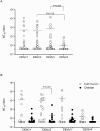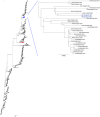Genomic sequencing and neutralizing serological profiles during acute dengue infection: A 2017 cohort study in Nepal
- PMID: 39535994
- PMCID: PMC11560038
- DOI: 10.1371/journal.pgph.0002966
Genomic sequencing and neutralizing serological profiles during acute dengue infection: A 2017 cohort study in Nepal
Abstract
Dengue virus (DENV) is a mosquito-borne flavivirus that poses a threat to nearly 50% of the global population. DENV has been endemic in Nepal since 2006; however, little is known about how DENV is evolving or the prevalence of anti-DENV immunity within the Nepalese population. To begin to address these gaps, we performed a serologic and genetic study of 49 patients from across Nepal who presented at central hospitals during the 2017 dengue season with suspected DENV infection. Of the 49 subjects assessed, 21 (43%) were positive for DENV NS1 antigen; of these; 5 were also anti-DENV IgM+ IgG+; 7 were DENV IgM+ IgG-, 2 were IgM- IgG+, and 7 were IgM-IgG- by specific ELISAs. Seven of the 21 NS1 positive sera were RNA positive by RT-PCR (six DENV2, one DENV3), suggesting that DENV2 was the dominant serotype in our cohort. Whole-genome sequencing of two DENV2 isolates showed similarity with strains circulating in Singapore in 2016, and the envelope genes were also similar to strains circulating in India in 2017. DENV-neutralizing antibodies (nAbs) were present in 31 of 47 sera tested (66%); among these, 20, 24, 26, and 12 sera contained nAbs against DENV1, 2, 3, and 4 serotypes, respectively. Additionally, 27 (58%) samples had nAbs against multiple serotypes (2 or more). Serology analysis suggested that 12 (26%) and 19 (40%) of the 47 subjects were experiencing primary and secondary DENV infections, respectively. Collectively, our results provide evidence for current and/or past exposure to multiple DENV serotypes in our cohort. These data suggest that expanded local surveillance of circulating DENV genotypes and population immunity will be important to effectively manage and mitigate future dengue outbreaks in Nepal.
Copyright: © 2024 Prajapati et al. This is an open access article distributed under the terms of the Creative Commons Attribution License, which permits unrestricted use, distribution, and reproduction in any medium, provided the original author and source are credited.
Conflict of interest statement
The authors have declared that no competing interests exist.
Figures



Update of
-
Genomic sequencing and neutralizing serological profiles during acute dengue infection: A 2017 cohort study in Nepal.bioRxiv [Preprint]. 2024 Jun 5:2024.06.03.597174. doi: 10.1101/2024.06.03.597174. bioRxiv. 2024. Update in: PLOS Glob Public Health. 2024 Nov 13;4(11):e0002966. doi: 10.1371/journal.pgph.0002966. PMID: 38895290 Free PMC article. Updated. Preprint.
Similar articles
-
Genomic sequencing and neutralizing serological profiles during acute dengue infection: A 2017 cohort study in Nepal.bioRxiv [Preprint]. 2024 Jun 5:2024.06.03.597174. doi: 10.1101/2024.06.03.597174. bioRxiv. 2024. Update in: PLOS Glob Public Health. 2024 Nov 13;4(11):e0002966. doi: 10.1371/journal.pgph.0002966. PMID: 38895290 Free PMC article. Updated. Preprint.
-
Whole Genome Sequencing of Dengue Virus Serotype 2 from Two Clinical Isolates and Serological Profile of Dengue in the 2015-2016 Nepal Outbreak.Am J Trop Med Hyg. 2021 Jan;104(1):115-120. doi: 10.4269/ajtmh.20-0163. Am J Trop Med Hyg. 2021. PMID: 33073748 Free PMC article.
-
Dengue virus surveillance in Nepal yields the first on-site whole genome sequences of isolates from the 2022 outbreak.BMC Genomics. 2024 Oct 24;25(1):998. doi: 10.1186/s12864-024-10879-x. BMC Genomics. 2024. PMID: 39449117 Free PMC article.
-
Circulating serotypes and genotypes of dengue virus during the 2023 outbreak in Eastern Nepal.J Clin Virol. 2024 Oct;174:105721. doi: 10.1016/j.jcv.2024.105721. Epub 2024 Aug 30. J Clin Virol. 2024. PMID: 39232301
-
Repeated exposure to dengue virus elicits robust cross neutralizing antibodies against Zika virus in residents of Northeastern Thailand.Sci Rep. 2021 May 5;11(1):9634. doi: 10.1038/s41598-021-88933-x. Sci Rep. 2021. PMID: 33953258 Free PMC article.
References
-
- WHO M. Dengue and severe dengue. Geneva. 2019.
Grants and funding
LinkOut - more resources
Full Text Sources
Miscellaneous
